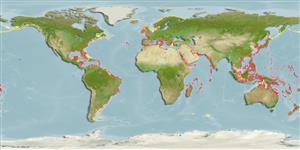Common names from other countries
Environment: milieu / climate zone / depth range / distribution range
Ecologia
; estuarina; intervalo de profundidade 0 - 29 m (Ref. 86643). Tropical
Indo-Pacific, Atlantic Ocean, Caribbean and the Mediterranean. Tropical and subtropical.
Length at first maturity / Tamanho / Peso / Idade
Maturity: Lm ? range ? - ? cm Max length : 30.0 cm H macho/indeterminado; (Ref. 3248)
Large colonies, as tall as 30 cm, with dark brown to black perisac. Polyp is white with a reddish tinge and has a circle of 10 to 18 filiform tentacles at the base and up to 12 capitate tentacles on the upper part of hydranth.
Height is based on colonies (Ref. 3248). Maximum depth from Ref. 116013. Distributed world-wide in warm seas (Ref. 3248). Known from tidal inlets, exposed areas of bays, including any ledges at their entrance, sounds, caves, shallow reefs, shallow coastal benthic habitats (< 25 m) (Ref. 86643), and on mangrove roots (Ref. 121478). Also found in Carrie Bow Cay, Belize, in patch reefs, high and low spur and groove zones, sand trough, outer ridge and fore-reef slopes on substrates composed of dead corals and gorgonians at depths of 2 to 18 m. As with other hydroids, this species exhibits a pelagic medusoid stage (Ref. 87156).
Life cycle and mating behavior
Maturidade | Reprodução | Desova | Ovos | Fecundidade | Larvas
Species exhibits both asexual and sexual reproduction by budding during hydroid stage and release of gametes in medusae stages (Ref. 1663, p. 15, 18). Period of reproductive maturity recorded for Carrie Bow Cay, Belize is from 17th April to 21st June, during which the samples collected had gonophores or medusa buds (Ref. 87156).
Migotto, A.E., A.C. Marques, A.C. Morandini and F.L. da Silveira. 2002. (Ref. 813)
Status na Lista Vermelha da IUCN (Ref. 130435)
Status no CITES (Ref. 108899)
Not Evaluated
Not Evaluated
Uso pelos humanos
| FishSource |
Ferramentas
Fontes da internet
Estimates based on models
Preferred temperature
(Ref.
115969): 9 - 29.1, mean 27 (based on 5999 cells).
Vulnerabilidade
Low vulnerability (20 of 100).
Categoria de preço
Unknown.
